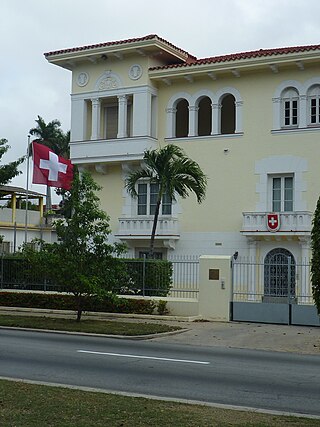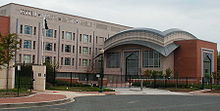
A diplomatic mission or foreign mission is a group of people from a state or organization present in another state to represent the sending state or organization officially in the receiving or host state. In practice, the phrase usually denotes an embassy or high commission, which is the main office of a country's diplomatic representatives to another country; it is usually, but not necessarily, based in the receiving state's capital city. Consulates, on the other hand, are smaller diplomatic missions that are normally located in major cities of the receiving state. As well as being a diplomatic mission to the country in which it is situated, an embassy may also be a nonresident permanent mission to one or more other countries.

Geography is an important factor in informing Iran's foreign policy. Following the 1979 Iranian Revolution, the newly formed Islamic Republic, under the leadership of Ayatollah Khomeini, dramatically reversed the pro-American foreign policy of the last Shah of Iran Mohammad Reza Pahlavi. Since the country's policies then oscillated between the two opposing tendencies of revolutionary ardour to eliminate non-Muslim Western influences while promoting the Islamic revolution abroad, and pragmatism, which would advance economic development and normalization of relations, bilateral dealings can be confused and contradictory.

Ambassadors of the United States are persons nominated by the president to serve as the United States' diplomatic representatives to foreign nations, international organizations, and as ambassadors-at-large. Under Article II, Section 2 of the U.S. Constitution, their appointment must be confirmed by the United States Senate; while an ambassador may be appointed during a recess, they can serve only until the end of the next session of Congress, unless subsequently confirmed.
The Algiers Accords of January 19, 1981 was a set of obligations and commitments undertaken independently by the United States and Iran to resolve the Iran hostage crisis, brokered by the Algerian government and signed in Algiers on January 19, 1981. The crisis began from the takeover of the American embassy in Tehran on November 4, 1979, where Iranian students took hostage of present American embassy staff. By this accord and its adherence, 52 American citizens were able to leave Iran. With the two countries unable to settle on mutually agreeable terms, particularly for quantitative financial obligations, Algerian mediators proposed an alternative agreement model - one where each country undertook obligations under the accords independently, rather than requiring both countries to mutually adhere to the same terms under a bilateral agreement.

A protecting power is a country that represents another sovereign state in a country where said sovereign state lacks its own formal diplomatic representation in the protecting power’s state. It is common for protecting powers to be appointed when two countries break off diplomatic relations with each other. The protecting power is responsible for looking after the protected power's diplomatic property and citizens in the hosting state. If diplomatic relations were broken by the outbreak of war, the protecting power will also inquire into the welfare of prisoners of war and look after the interests of civilians in enemy-occupied territory.
On January 11, 2007, the United States military raided the Iranian Liaison Office in Erbil, Kurdistan Region, Iraq, ostensibly to detain two senior Iranian officials, but captured five mid-level diplomats instead. The U.S. government's position is that the office was used by the Iranian Islamic Revolutionary Guard Corps (IRGC) as a local headquarters. However, both Iranian and Kurdish officials state that it was a diplomatic mission in the city of Erbil.

Official diplomatic relations between the Republic of Azerbaijan and the Islamic Republic of Iran were established following the dissolution of the Soviet Union (1991). Iran and Azerbaijan share, to a large extent, the same history, religion, and culture. The territory of what is now called the Republic of Azerbaijan was separated from Iran in the first half of the 19th century, through the Russo-Persian Wars. In the area to the North of the river Aras, the territory of the contemporary Republic of Azerbaijan was part of Iran until it was occupied by Russia. Iran and Azerbaijan are both majority Shia Muslim nations. They have respectively the highest and second highest Shia population percentage in the world, as well as the history of Shi'ism which is rooted in both nations from exactly the same moment in history, whereas the majority of the population of both their neighboring nations are either predominantly Christians or Sunni Muslims. However, there are some tensions between the two countries as its political alignment may vary by degree. The Republic of Azerbaijan has become increasingly pro-Western aligned, and is an ally of Israel, Turkey and the United States while the Islamic Republic of Iran is largely pro-Russian and pro-Chinese aligned due to its hostility towards the U.S. and has been targeted with sanctions. Iranian politicians, like Mohammad Hosseini, have called Azerbaijan an Israeli proxy.

Iranian passports are issued to nationals of Iran for the purpose of international travel. The passport serves as a proof of Iranian citizenship. The Iranian passports are burgundy, with the Iranian emblem emblazoned on the top of the front cover.

Iran–Serbia relations are diplomatic relations between the Islamic Republic of Iran and the Republic of Serbia. Iran has an embassy in Belgrade and Serbia has an embassy in Tehran. In 2017, the government of Serbia announced that in order to improve bilateral relations as well as to attract tourists and investors to Serbia, it has passed a legislation to abolish visa requirements for citizens of Iran and India intending to travel to the country.

Canada and Iran have had no formal diplomatic relations since 2012. In the absence of diplomatic representation, Italy acts as the protecting power for Canada in Iran and Switzerland acts as Iran's protecting power in Canada.

The Embassy of the United States of America in Tehran was the American diplomatic mission in the Imperial State of Iran. Direct bilateral diplomatic relations between the two governments were severed following the Iranian Revolution in 1979, and the subsequent seizure of the embassy in November 1979.

The Former Embassy of Iran in Washington, D.C. was the Imperial State of Iran's diplomatic mission to the United States. Direct bilateral Iran–United States relations between the two governments were severed following the Iranian Revolution in 1979, and the subsequent seizure of hostages at the U.S. Embassy in Tehran, Iran.

The Embassy of the United Kingdom in Tehran is the United Kingdom's diplomatic mission to the Islamic Republic of Iran. It is located at 172 Ferdowsi Avenue in Tehran.

The Embassy of Iran in London is the diplomatic mission of Iran in the United Kingdom. It is located in a terrace overlooking Hyde Park in South Kensington, Westminster, London, next to the embassy of Ethiopia. Iran also maintains a Consular Section at 50 Kensington Court, South Kensington. The embassy building, along with the Ethiopian Embassy and the Polish Institute and Sikorski Museum, is one of a group of Grade II listed stucco buildings.












